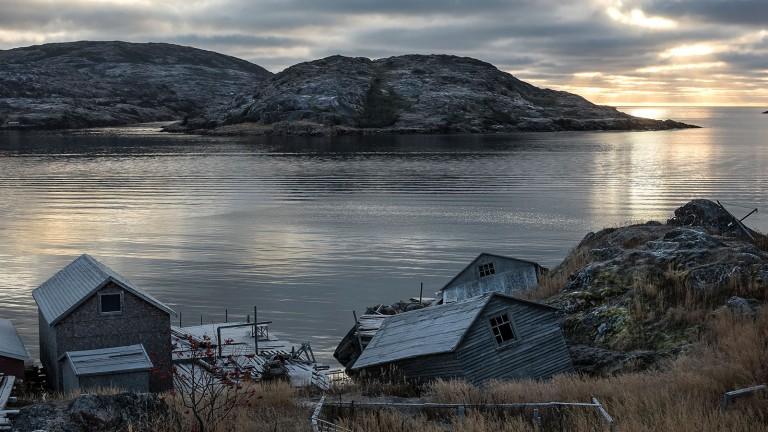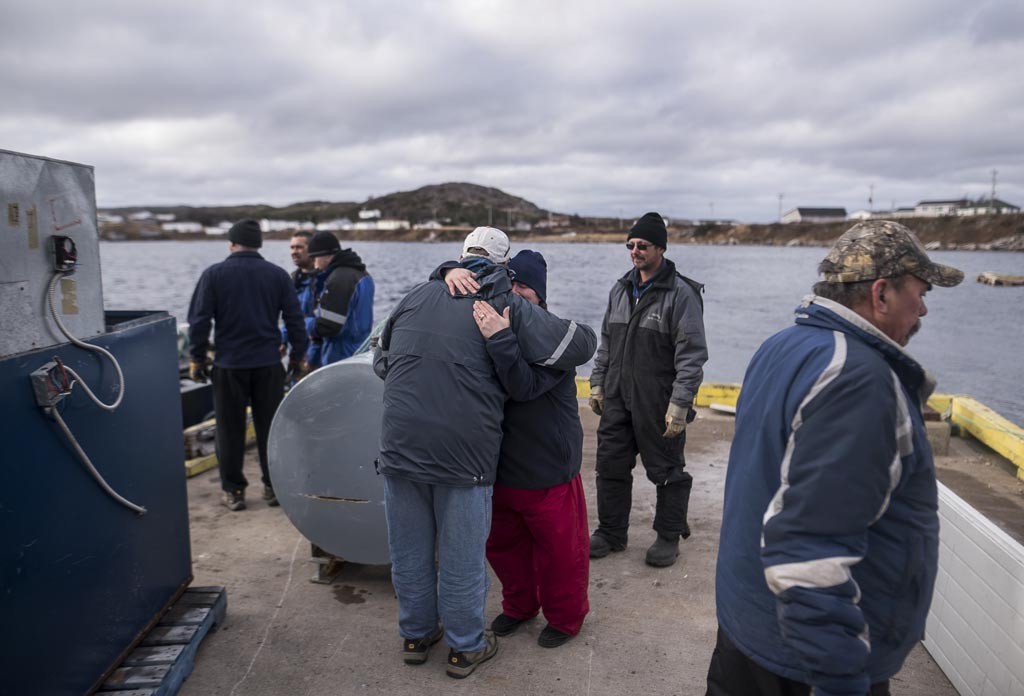The day the lights went out in William’s Harbour
The 34 residents of the town packed up their belongings and boarded a ferry, saying good-bye to their land and a way of life

Abandoned and dilapidated fishing stages are seen in the final hours before resettlement from William’s Harbour off the southeastern coast of Labrador on Friday, November 10, 2017. (Photograph by Darren Calabrese)
Share

On the eve of resettlement in William’s Harbour, the VHF radio in George Russell’s kitchen crackles to life. Someone, somewhere near this remote island in southeastern Labrador broadcasts a ballad familiar to anyone with ties here.
Jason Flynn’s Morning Tide Take Me Home has played in homes and cod festivals of yesteryear. But tonight, the former resident’s anthem for William’s Harbour eerily floods George’s near-empty bungalow like a funeral song.
George, a quiet, moustachioed man in his ‘70s, has rumbled off on his quad, down the gravel road that connects the homes on the bluff for a last “wit and a chat”—a drink in a neighbour’s shed.
His wife Louise Russell is packing, pausing just long enough to take phone calls from well-wishers.
“Sometimes you gets right emotional,” says Louise, 63, about leaving William’s Harbour. “You gets this lump in your throat. You just got to go and have a little cry and get sad for a bit.”
On Nov. 10, William’s Harbour was effectively wiped off the map. The last residents stepped aboard the MV Marine Eagle for a final, three-hour voyage out the narrow inlet of Alexis Bay to Port Hope Simpson.
All of the island’s 34 permanent residents surrendered to government-sponsored relocation this past summer, mainly because the aging population could no longer handle the inhospitable winters. They gave up title to their homes in exchange for a government payout of up to $270,000 per household. The provincial government cut all services, like water, hydro, air ambulance, ferry transportation and road maintenance. (In future, the province’s updated resettlement policy will no longer take land titles.)
The southern Inuit community was built into the edge of a rugged outcrop at the end of a narrow strait about 400 km from Happy Valley-Goose Bay. The waters are renowned for the genetically-distinct golden cod, and the locals say you can fill your freezer with the bronze-hued fish on just five gallons of gas.
The relocation of William’s Harbour cost Newfoundland and Labrador $4-million, but it will eventually save $7.9-million over 20 years. This is much-needed savings for a province facing the highest deficit as a percentage of the GDP in Canada, and the highest debt ($13.6 billion) in its history, according to a recent auditor general’s report.
What the government balance sheet doesn’t factor is the loss of a way of life. In the case of William’s Harbour, relocating means many elderly residents lost access to traditional Indigenous fishing berths and hunting grounds, said Todd Russell, president of NunatuKavut, the territory of the southern Inuit people of Labrador.
“Our identity is not about saying who we are. It’s about the relationship to the land, the water, the animals,” said Todd, who is George’s nephew. “This is what’s fundamental.”
“We might not often think about it, but southern Inuit communities like William’s Harbour have contributed to the fabric that is Canada. There’s no way to translate that into a cost-savings as a measurement to government.”
An unspoken rule is everyone has their own fishing, hunting and trapping spots that no one else treads on. “If you want to go for a hunt, you know exactly where to go to get a spruce partridge or tail your rabbit. You knows the place even before you goes there,” said George.
“I gotta get used to jumping in the truck now. We’ll have to adapt I suppose. We got no other choice now.”
Today, resettlement happens much more sporadically than it used to in the 1950s to 1970s, when some 28,000 people were relocated from 279 communities. In the last 15 years, only five communities in Newfoundland and Labrador have resettled.
Over the years, resettlement policies have changed and so has the payout. In 2013, the government upped the one-time resettlement amount from $100,000 to up to $270,000 per household. William’s Harbour is the first community to cash in. More resettlement is likely on the horizon. Three other communities are at various stages of relocation now. And the province’s aging demographics point to more to come. Twenty per cent of the population is older than age 64, plus the province’s sparsely populated geography makes it expensive and inefficient to provide government services in remote communities.
George’s roots go back to the very beginnings of the community. Although the area had been used by Indigenous people for centuries, the island was officially settled in the 1840s by an Inuk man named Samuel Kippenhhuck and later his son-in-law, William Russell, who is George Russell’s great great grandfather.
As a boy, George spent summers with his grandfather and father, Bill Tom, who was a community leader and prolific hunter. They lived in fish shacks built into the shoreline in William’s Harbour and spent winters inland at Rexon’s Cove.
When George and Louise married 44 years ago in the little white Anglican church on the hill, a generator supplied their heat and lights. The arrival of the diesel plant 38 years ago, powered up by none other than George himself, led to a tiny population boom.
At its peak, there were 30 children in the one-room school house which was so crowded that kids attended class in shifts until a new two-room schoolhouse could be built. (George’s grandsons Devon and Dwight Russell were the last two children to attend the school.)
A fish plant employed dozens, and kids as young as 11 could make a buck cutting out cod tongues.
Like hundreds of other fishing outports in Newfound and Labrador, the moratorium on cod fishing in 1992 was the beginning of the end for William’s Harbour.
While at once a Shangri-la for fishing, trapping and picking partridge berries in summer, come winter, it’s wind-whipped and punishing. Windows buckle and snow drifts to the roof lines. A few winters ago, residents were stranded for nearly three weeks without access to the bi-weekly mail flights for prescriptions or medical emergencies. The ice was too thin to cross by snowmobile; the wind too blustery for planes to land on the tiny airstrip.
“No one hardly speaks when the weather forecast is getting bad,” said George. “When the spring comes, everybody lightens up proper.”
To celebrate the end of the winter, one local tradition is that the first person to catch a salmon in the spring invites everyone for supper to share the bounty.
Residents bandied resettlement for years before finally surrendering. Trevor Larkham, in his 50s, voted to leave so his elders wouldn’t have to endure the harsh winters, but he doesn’t plan on abandoning ship. On the eve of resettlement, he hooked up his home to a generator, with the intent to buy himself an extra month to trap more foxes and river otters. “I’m more sad for them than myself,” he said about his parents and aunts and uncles leaving home. “I can come back here.”
George and Louise hope to as well, and they cling to this idea in the final hours.
Inside his vinyl-sided bungalow, George glances one last time at the kitchen clock and steps into his boots.
Louise, knowing he hasn’t slept the past two nights, coaxes him to just let the town’s diesel generator run out on its own. But George is a man of duty. He straddles his quad and rumbles off one last time to the blue metal-sided building. A monstrous hum that brought light and life to this island 38 years ago greets him at the door. He flicks the switch and silence floods the room: “That’s all she wrote, b’ye.”